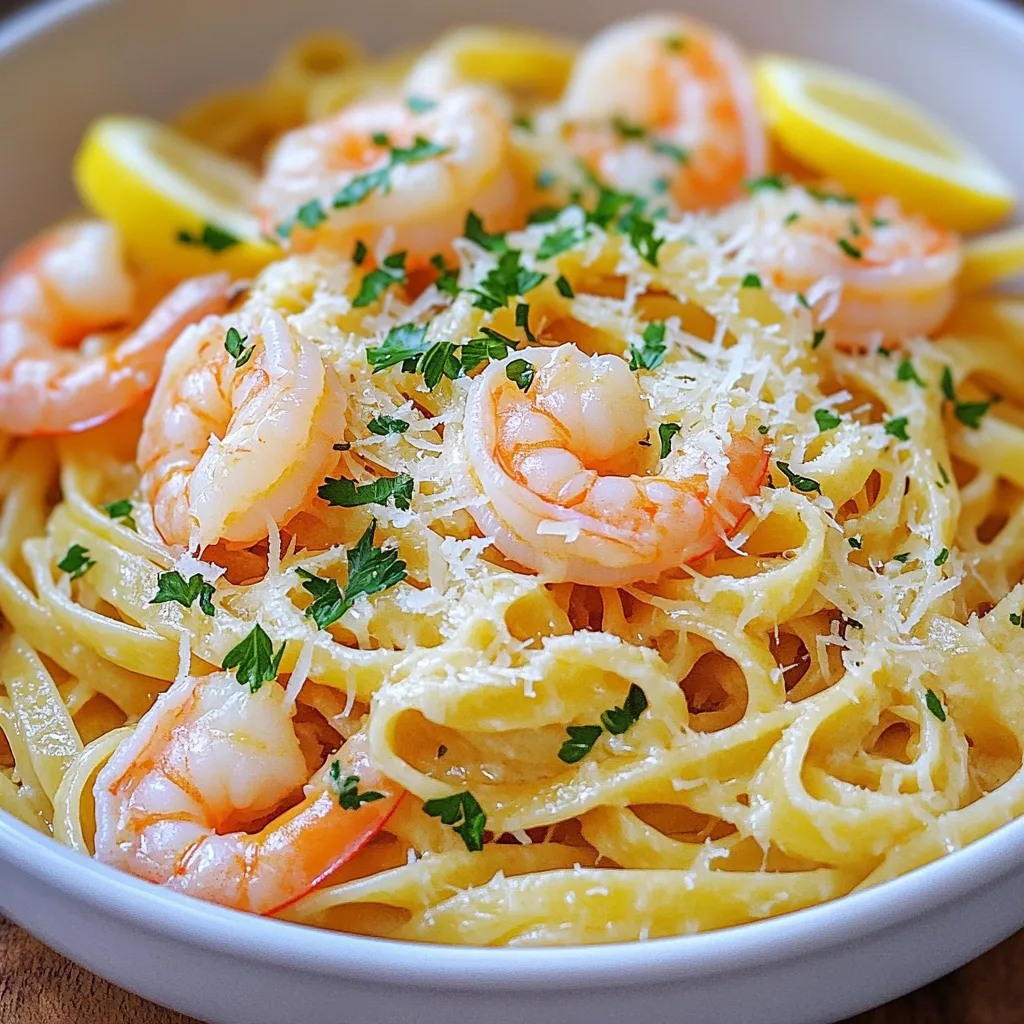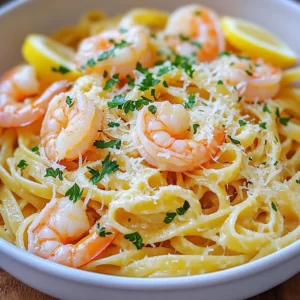If you’re craving a quick and delicious meal, Garlic Butter Shrimp Pasta is your answer. This dish combines tender shrimp, rich butter, and a pop of lemony flavor for an unforgettable experience. It’s easy to make, yet packed with taste that will impress anyone at your dinner table. With simple ingredients and straightforward steps, you can whip up this culinary delight in no time. Let’s dive into this flavorful journey!

Ingredients
Main Ingredients List
– 8 oz linguine or spaghetti
– 1 lb large shrimp, peeled and deveined
– 4 tablespoons unsalted butter, divided
Flavor Enhancers
– 4 cloves garlic, finely minced
– 1 teaspoon red pepper flakes
– Zest and juice of 1 lemon
Garnishing Ingredients
– 1/4 cup fresh parsley, finely chopped
– Salt and freshly ground black pepper, to taste
– Grated Parmesan cheese, to serve
I love using fresh ingredients to make this dish shine. The shrimp brings a sweet flavor. I prefer large shrimp for their juicy bite. They cook quickly and soak up flavors well. The linguine or spaghetti adds a nice texture and holds the sauce well. I use unsalted butter for a clean taste.
Garlic is the star here. I finely mince it to release its flavor. The red pepper flakes give a gentle kick. You can adjust this to your taste. The lemon zest and juice brighten the dish. They add a fresh contrast to the rich butter.
For garnishing, I use fresh parsley for color and flavor. It also adds a nice crunch. Salt and pepper enhance all the flavors. Lastly, grated Parmesan cheese is a must for serving. It adds a creamy touch that completes this dish.
These ingredients come together to create a simple yet flavorful meal.
Step-by-Step Instructions
Cooking the Pasta
To start, fill a large pot with water and add salt. Bring it to a rolling boil. Add 8 oz of linguine or spaghetti. Cook it as per the package’s directions until it is al dente. Once it’s ready, be sure to save ½ cup of the starchy pasta water. Then, drain the pasta and set it aside.
Reserving pasta water is key. This starchy water helps bind the sauce to the pasta, giving it a nice creamy texture later.
Sautéing the Shrimp
Next, grab a spacious skillet and place it over medium heat. Melt 2 tablespoons of butter in the skillet. Add 1 lb of large shrimp in a single layer. Make sure they don’t crowd the pan. Season the shrimp with salt, freshly ground black pepper, and 1 teaspoon of red pepper flakes.
Cook for about 2 to 3 minutes on each side. The shrimp should turn pink and be fully cooked. After that, carefully take the shrimp out and transfer them to a plate. This method ensures your shrimp are juicy and flavorful.
Creating the Garlic Butter Sauce
Now, let’s make the garlic butter sauce. In the same skillet, add the remaining 2 tablespoons of butter. Toss in 4 finely minced garlic cloves. Sauté for about 1 minute, stirring constantly. You want the garlic to be fragrant and lightly golden.
Be cautious not to burn the garlic, as burnt garlic tastes bitter. Once it’s ready, it’s time to bring back the shrimp.
Combining and Serving
Return the cooked shrimp to the skillet with the garlic butter. Then, add the lemon zest and juice from 1 lemon, followed by the drained pasta. Gently toss everything together. If the pasta seems dry, add a bit of the reserved pasta water to achieve a smooth and even coating.
Stir in ¼ cup of freshly chopped parsley. Taste your dish, and adjust the seasoning with extra salt and pepper if needed. Serve the pasta in bowls and sprinkle generously with grated Parmesan cheese. Enjoy the delightful mix of flavors!
Tips & Tricks
Cooking Tips
To cook perfect al dente pasta, start with a large pot of salted water. Bring it to a rolling boil before adding your linguine or spaghetti. Follow the package directions, but check a minute early. The pasta should be firm yet tender. Remember to reserve half a cup of pasta water before draining. This starchy water helps bind the sauce later.
When sautéing shrimp, keep them in a single layer in the pan. This helps them cook evenly. Cook for about 2-3 minutes on each side. Look for a bright pink color to know they are done. Overcrowding can lead to uneven cooking, so work in batches if necessary.
Flavor Optimization
Want to spice things up? Adjust the red pepper flakes to your taste. Start with one teaspoon, then add more if you like heat. Mix it well with the shrimp for even flavor.
To enhance the lemon flavor, use both lemon zest and juice. The zest adds a bright note, while the juice gives it a fresh kick. You can also add more zest after cooking for extra brightness.
Presentation Tips
For garnishing, fresh parsley adds a pop of color. Sprinkle it on top before serving. You can also add lemon wedges on the side. This makes the dish look more inviting.
Serve your Garlic Butter Shrimp Pasta in individual bowls. For a touch of elegance, pair it with a green salad. The fresh greens balance the richness of the pasta.

Variations
Ingredient Substitutions
If you want to change the pasta, try gluten-free or whole grain options. These can add a twist and make the dish fit your needs. You can also swap shrimp for chicken or tofu. Chicken gives a heartier bite, while tofu is great for a vegetarian choice.
Flavor Variations
Adding veggies can brighten the dish. Spinach or cherry tomatoes work well. They not only add color but also enhance the taste. You can also play with herbs. Basil or cilantro can bring fresh notes to the garlic butter sauce. Experiment and find what you love!
Dietary Considerations
To make this dish low-carb or keto-friendly, swap pasta for zucchini noodles or spaghetti squash. This lets you enjoy the flavors without the carbs. If you need a dairy-free option, use olive oil instead of butter. Nutritional yeast can replace cheese and add a cheesy flavor without the dairy.
Storage Info
Leftovers
To store Garlic Butter Shrimp Pasta, let it cool first. Place it in an airtight container. This helps keep the flavors fresh. You can also use plastic wrap if you don’t have a container. In the fridge, it lasts about three days. If you see any change in color or smell, it’s best to toss it.
Reheating Instructions
To reheat, you can use a skillet or the microwave. For the skillet, add a splash of water or broth. Heat on low, stirring gently. This keeps the shrimp tender and the pasta moist. If using a microwave, cover the bowl with a damp paper towel. This helps keep the dish from drying out. Heat in short bursts, stirring in between.
Freezing Tips
You can freeze Garlic Butter Shrimp Pasta, but it’s best to do so without the shrimp. Cooked shrimp may become rubbery after freezing. To freeze, place the pasta in a freezer-safe bag. Squeeze out excess air to prevent freezer burn. When you’re ready to eat, defrost in the fridge overnight. Reheat gently on the stove, adding a bit of water or broth.
FAQs
What is the best pasta for Garlic Butter Shrimp Pasta?
I love using linguine or spaghetti for this dish. Both types hold the sauce well. You can also try fettuccine for a thicker bite. When cooking, aim for al dente. This means the pasta should still have a slight bite. It helps create a great texture with the shrimp and sauce.
Can I make this recipe ahead of time?
Yes, you can prep some parts in advance. Cook the pasta and store it in the fridge. Keep it in a sealed container. You can also season and cook the shrimp ahead. Store them separately to keep them fresh. When ready to eat, just combine everything in a pan. Heat gently and add a splash of pasta water.
What sides pair well with Garlic Butter Shrimp Pasta?
To complete your meal, I suggest a fresh green salad. A crisp Caesar salad works great too. You can also serve garlic bread on the side. It’s perfect for soaking up extra sauce. Steamed vegetables like asparagus or broccoli add color and nutrition.
How can I make this dish spicier?
If you want heat, add more red pepper flakes. Start with a half teaspoon more for a kick. You can also mix in some sliced jalapeños for extra spice. Another option is to add a dash of hot sauce. Just remember to taste as you go!
This blog post shared how to make Garlic Butter Shrimp Pasta. We covered the main ingredients, key cooking steps, tips for flavor, and interesting variations. You learned about storing leftovers and reheating them. Remember, you can adjust spices and use different proteins or pasta. This dish is flexible and perfect for any meal. Enjoy your cooking and let your kitchen shine with this tasty recipe!


